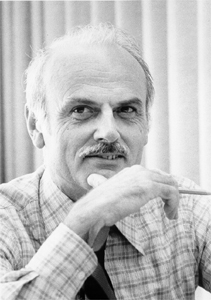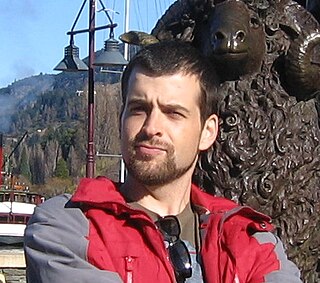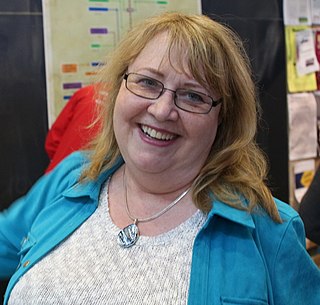
Edgar Frank "Ted" Codd was an English computer scientist who, while working for IBM, invented the relational model for database management, the theoretical basis for relational databases and relational database management systems. He made other valuable contributions to computer science, but the relational model, a very influential general theory of data management, remains his most mentioned, analyzed and celebrated achievement.
In database systems, durability is the ACID property that guarantees that the effects of transactions that have been committed will survive permanently, even in case of failures, including incidents and catastrophic events. For example, if a flight booking reports that a seat has successfully been booked, then the seat will remain booked even if the system crashes.

James Nicholas Gray was an American computer scientist who received the Turing Award in 1998 "for seminal contributions to database and transaction processing research and technical leadership in system implementation".

IBM Research is the research and development division for IBM, an American multinational information technology company headquartered in Armonk, New York, with operations in over 170 countries. IBM Research is the largest industrial research organization in the world and has twelve labs on six continents.
Peter Pin-Shan Chen is a Taiwanese American computer scientist. He is a (retired) distinguished career scientist and faculty member at Carnegie Mellon University and Distinguished Chair Professor Emeritus at LSU. He is known for the development of the entity–relationship model in 1976.
M. Dale Skeen is an American computer scientist. He specializes in designing and implementing large-scale computing systems, distributed computing and database management systems.
Amit Sheth is a computer scientist at University of South Carolina in Columbia, South Carolina. He is the founding Director of the Artificial Intelligence Institute, and a Professor of Computer Science and Engineering. From 2007 to June 2019, he was the Lexis Nexis Ohio Eminent Scholar, director of the Ohio Center of Excellence in Knowledge-enabled Computing, and a Professor of Computer Science at Wright State University. Sheth's work has been cited by over 48,800 publications. He has an h-index of 106, which puts him among the top 100 computer scientists with the highest h-index. Prior to founding the Kno.e.sis Center, he served as the director of the Large Scale Distributed Information Systems Lab at the University of Georgia in Athens, Georgia.

Joseph M. Hellerstein is an American professor of computer science at the University of California, Berkeley, where he works on database systems and computer networks. He co-founded Trifacta with Jeffrey Heer and Sean Kandel in 2012, which stemmed from their research project, Wrangler.

Samuel R. Madden is an American computer scientist specializing in database management systems. He is currently a professor of computer science at the Massachusetts Institute of Technology.
Elisa Bertino is a professor of computer science at Purdue University and is acting as the research director of CERIAS, the Center for Education and Research in Information Assurance and Security, an institute attached to Purdue University. Bertino's research interest include data privacy and computer security.

Patricia G. Selinger is an American computer scientist and IBM Fellow, best known for her work on relational database management systems.

Michael Ralph Stonebraker is a computer scientist specializing in database systems. Through a series of academic prototypes and commercial startups, Stonebraker's research and products are central to many relational databases. He is also the founder of many database companies, including Ingres Corporation, Illustra, Paradigm4, StreamBase Systems, Tamr, Vertica and VoltDB, and served as chief technical officer of Informix. For his contributions to database research, Stonebraker received the 2014 Turing Award, often described as "the Nobel Prize for computing."

Jennifer Widom is an American computer scientist known for her work in database systems and data management. She is notable for foundational contributions to semi-structured data management and data stream management systems. Since 2017, Widom is the dean of the School of Engineering and professor of computer science at Stanford University. Her honors include the Fletcher Jones Professor of Computer Science and multiple lifetime achievement awards from the Association for Computing Machinery.
Richard Thomas Snodgrass is an American computer scientist and writer and is professor emeritus at the University of Arizona. He is best known for his work on temporal databases, query language design, query optimization and evaluation, storage structures, database design, and ergalics.

Opher Etzion is an Israeli author and computer scientist. He has been instrumental in the development of the complex event processing area of computer science.

Martin L. Kersten was a computer scientist with research focus on database architectures, query optimization and their use in scientific databases. He was an architect of the MonetDB system, an open-source column store for data warehouses, online analytical processing (OLAP) and geographic information systems (GIS). He has been (co-) founder of several successful spin-offs of the Centrum Wiskunde & Informatica (CWI).
A blockchain is a distributed ledger with growing lists of records (blocks) that are securely linked together via cryptographic hashes. Each block contains a cryptographic hash of the previous block, a timestamp, and transaction data. Since each block contains information about the previous block, they effectively form a chain, with each additional block linking to the ones before it. Consequently, blockchain transactions are irreversible in that, once they are recorded, the data in any given block cannot be altered retroactively without altering all subsequent blocks.
Hyperledger is an umbrella project of open source blockchains and related tools that the Linux Foundation started in December 2015. IBM, Intel, and SAP Ariba have contributed to support the collaborative development of blockchain-based distributed ledgers. It was renamed the Hyperledger Foundation in October 2021.

Michael James Carey is an American computer scientist. He is currently a Distinguished Professor (Emeritus) of Computer Science in the Donald Bren School at the University of California, Irvine and a Consulting Architect at Couchbase, Inc..
Gennaro "Jerry" Cuomo is an American software engineer who has worked for IBM since 1987. Holding the title of IBM Fellow, Cuomo is known as one of the founding fathers of IBM WebSphere Software, a software framework and middleware that hosts Java-based web applications.










